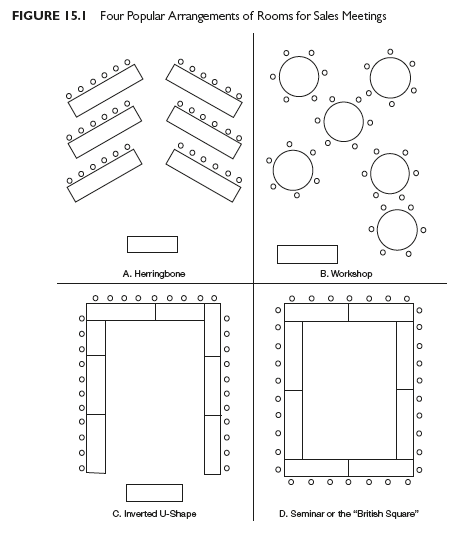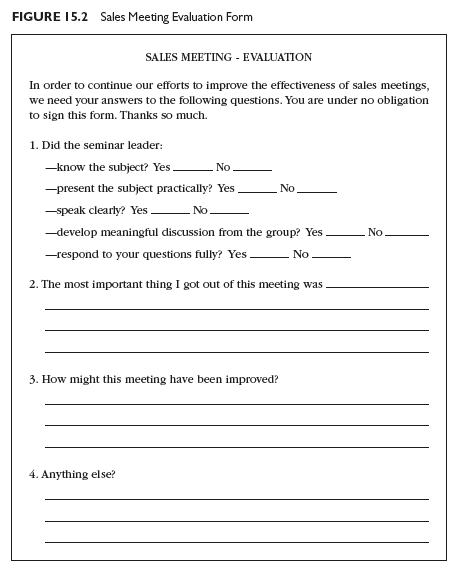Think of the relationship of job satisfaction to job performance. According to Herzberg’s motivation-hygiene theory, job performance leads to job satisfaction. Many managers believe exactly the opposite—job satisfaction leads to job performance. Most studies of industrial workers show a positive relationship between job satisfaction and job performance, but there is little agreement as to the direction of this relationship or the extent to which either satisfaction or performance or both are determined by other factors. It is misleading to assume that job satisfaction leads to improved job performance. Sales personnel who are “happy in their jobs” too often are people with little ambition and frequently report to managers who either misuse performance standards or do not know how to measure performance.
The motivational practices of many companies appear directed toward making sales personnel unhappy with their current performance in an effort to stimulate improved performance. Is there danger that this will decrease job satisfaction? Or is it possible—at least among some groups of sales personnel—that decreased job satisfaction stimulates improved job performance?1
In any event, then, we are better off focusing upon improving job performance rather than upon increasing job satisfaction. The purpose is to accomplish more than making sales personnel happier with their jobs. It is to improve job performances, regardless of the approach used.
SALES MEETINGS
Sales meetings are important both for communication and motivational purposes. When sales personnel are on the road without the day-to-day opportunity for employer communication and supervision, periodic group meetings are valuable for exchanging information and ideas. They also provide occasions for motivating individual sales personnel through group pressures.
Most important, they provide occasions for management to stimulate the group to raise its standards to reasonable and acceptable performance.
1. Planning and Staging Sales Meetings
Planning a sales meeting requires five major decisions: (1) defining the specific meeting goals, (2) deciding meeting content, (3) determining methods of conducting the meeting, (4) deciding how to execute (hold) the meeting, and (5) deciding how to evaluate the results.
Goals. In planning any sales meeting, it is important to have clearly defined objectives. The underlying purposes, of course, are to communicate and motivate. But more specific goals are required for holding a meeting. A new product may be about ready for introduction or research may have uncovered new insights on customer attitudes and behavior, and either of these could lead to meetings (of the sales training type) to communicate these matters to sales personnel and it is hoped, to motivate them. Or supervisory reports might have indicated that many sales personnel are deficient in applying sales techniques, and this could lead to a sales meeting, aimed to improve these skills. Or there may be new company policies or sales goals requiring explanation, and the meeting may aim not only to communicate but to use this important information to motivate the group. Running throughout all meeting purposes, of course, is the common aim of altering the attitudes of sales personnel so as to modify their behavioral patterns in ways leading to improved job performances.
Other specific aims of meetings include (1) improving the quality of sales force reports, (2) orienting sales personnel on the advertising program and showing how they can tie in their efforts with it, (3) increasing the effectiveness with which sales personnel use their time, and (4) introducing new services (such as inventory control assistance) for customers.
In setting a meeting’s specific aims, the effective executive answers three important questions. (1) Are these aims clear and attainable? (2) Are they realistic in terms of time, audience, and other conditions? (3) Will the probable results justify the estimated costs?
Content. Determining a meeting’s content is a matter of planning its agenda. An agenda, by definition, is a list or an outline of things to be considered or done during a meeting. Content, derives directly from the meeting’s specific aims. Say, for example, that there is an industry rumor that a strong competitor is about to introduce a fantastic new product, and company sales personnel may have high levels of anxiety. Thus, a meeting may be planned with the specific aim of reducing anxiety through informing sales personnel on what the company knows about the competitor’s
forthcoming new product and the company’s plans for counteracting it. In this situation, content might include (1) what we know about X’s new product, (2) what we think the trade’s reactions will be and why, (3) what your company is doing, and (4) what you should do and how.
Method. The methods used in conducting a sales meeting, of course, depend upon the aim and content as well as upon the time available and meeting place. Most local sales meetings, held rather frequently, are short and participative in nature; consequently, group discussion is generally used. Regional and national sales meetings, held less often, run for two or more days, have more ambitious aims and wider content, so they utilize a mix of methods.
Execution. The execution phase is of key importance to meeting success. Decisions are reached on speakers, seminar leaders, meeting site, and time. Still other execution decisions, outwardly trivial, contribute significantly to a meeting’s success or failure.
Among these seemingly trivial decisions is room arrangement. Most sales meetings, because of their underlying purposes of communicating and motivating, require active participation by attendees. The conventional classroom, as found in most educational institutions, is set up for the lecture method— seats in rows and columns. To stimulate participation, departures from the conventional arrangement are necessary. Figure 15.1 shows four popular arrangements. The herringbone breaks up the inhibiting influence of the conventional classroom arrangement—and is widely used when the presentation is basically lecture but with some participation—with the herringbone, attendees see more of others attending than with the conventional arrangement. The workshop is appropriate when smaller groups are to hold buzz sessions on particular topics and report—round tables are preferred, but rectangular ones are also used. The inverted U-shape and the seminar or “British square” are used where considerable participation by the attendees is important.
Among other seemingly trivial execution decisions are those on audiovisual equipment and supplies, provision of materials to attendees (including pads and pencils), timing of breaks and refreshments, and starting time and closing time. Inappropriate decisions on any of these detract from a meeting’s effectiveness.
Evaluation. The evaluation phase is often neglected by meeting planners. Yet it is important, especially if management desires to improve meeting effectiveness. The basis for evaluation should be whether the meeting accomplished its aims. To determine this, participant feedback is necessary. Figure 15.2 is a sales meeting evaluation form. This form was designed to evaluate a seminar—other forms are needed to evaluate other types of meetings. The best practice is to design a new form to evaluate each sales meeting held.

2. National Sales Meetings
The costs of bringing the entire sales force to a central site are substantial, but national sales meetings are sometimes appropriate. If, for example, comprehensive changes in marketing or sales policies are being made, a national meeting can introduce these changes rapidly and uniformly, providing standardized explanations and answers to questions. Moreover, major executives attend a national meeting but not a series of decentralized meetings—and their attendance provides more stimulation than written or recorded messages at decentralized meetings.

There are other advantages in holding national sales meetings. Sales personnel meet informally with their counterparts from elsewhere and learn from the interchange of experience. On finding that others face and solve similar problems, sales personnel are encouraged to find their own solutions. Meeting home office personnel should result in better coordination between the office and the field. The size of the national meeting generates contagious enthusiasm. If the meeting is held at or near a factory, there is opportunity for product training and to acquaint sales personnel with technical manufacturing details.
The national sales meeting has drawbacks, in addition to the expense. It is difficult to find a convenient time for all sales personnel to attend, unless the product line is seasonal. Company routine is disrupted and competitors may cut into market share while sales personnel are away. However, more aggressive selling resulting from the national meeting should more than compensate for any temporary lapse in sales coverage.
3. Regional Sales Meetings
The trend is away from national and toward regional sales meetings. The reasons are several. Instead of the field sales force converging upon the central office, headquarters’ sales executives and personnel attend the decentralized meetings, reducing total travel costs and lowering lost selling time. Headquarters’ executives, brought into direct contact with field personnel, learn about current problems at firsthand. Each regional meeting may have a program designed to emphasize unique problems of that region. The smaller attendance should increase participation time per person attending.
Regional sales meetings have some disadvantages. Demands on executive time may be excessive; consequently, top sales executives often rotate attendance among regional meetings. The smaller percentage of the top management in attendance depreciates the meeting’s importance in the eyes of the sales staff and, because total attendance is smaller, developing a spirit of contagious enthusiasm is more difficult.
The stimulating effect of the regional meeting is reduced further by the pressure to economize. The costs of conducting a series of meetings, for example, preclude using the top-flight speakers and entertainers featured at national meetings. Furthermore, the total costs of holding several meetings may equal or exceed those of one large national meeting, because much planning and organizational expense is not fixed but is incurred separately for each meeting.
4. Executive Opposition to National and Regional Sales Meetings
Many sales executives oppose both national and regional sales meetings. Some say that likely results do not justify expected costs, but they admit that many benefits, such as the effect on sales force morale, cannot be measured in monetary terms. Other executives, especially those in industries without slack selling seasons, contend that they can ill afford to have sales personnel away from the field, even for a week. Still others object to the demands on their own time. In a few cases, sales executives oppose national or regional meetings because of a low sales force morale. They fear that sales personnel will use the meeting to compare complaints and to strengthen their convictions that the company is a bad place to work.
5. Local Sales Meetings
Local sales meetings are conducted weekly or biweekly by district sales managers and last from fifteen minutes to several hours. The strength of the local sales meeting is its informality, each salesperson having an opportunity to pose questions and to state personal views. Local sales meetings are occasions for sales personnel to get together, become better acquainted, and strengthen group identity.
6. Virtual Sales Meetings
Virtual sales meetings like webinars are as easy as a phone call. Sales organizations can conduct virtual meetings to increase sales performance with more frequent trainings to build selling skills, product knowledge and awareness about the competitors. It can also be used to share information with the salesperson, across sales teams, field to head office, and vice versa. In addition to cost savings, the virtual meetings help to increase the selling time as sales people in the field are not losing time to travel. Virtual sales meetings retain the advantages of traditional sales meetings while reducing its cost and time expenditures
Source: Richard R. Still, Edward W. Cundliff, Normal A. P Govoni, Sandeep Puri (2017), Sales and Distribution Management: Decisions, Strategies, and Cases, Pearson; Sixth edition.

Thanks for helping out, wonderful information.